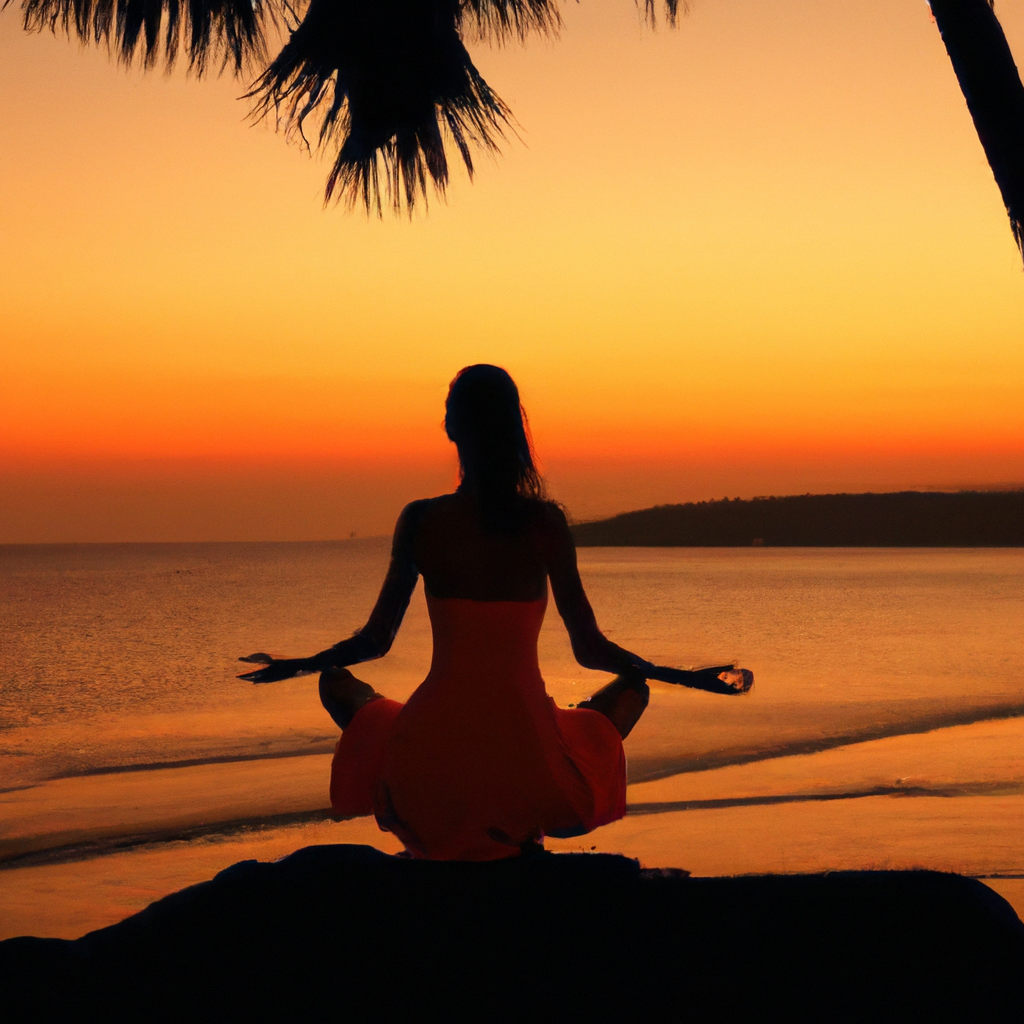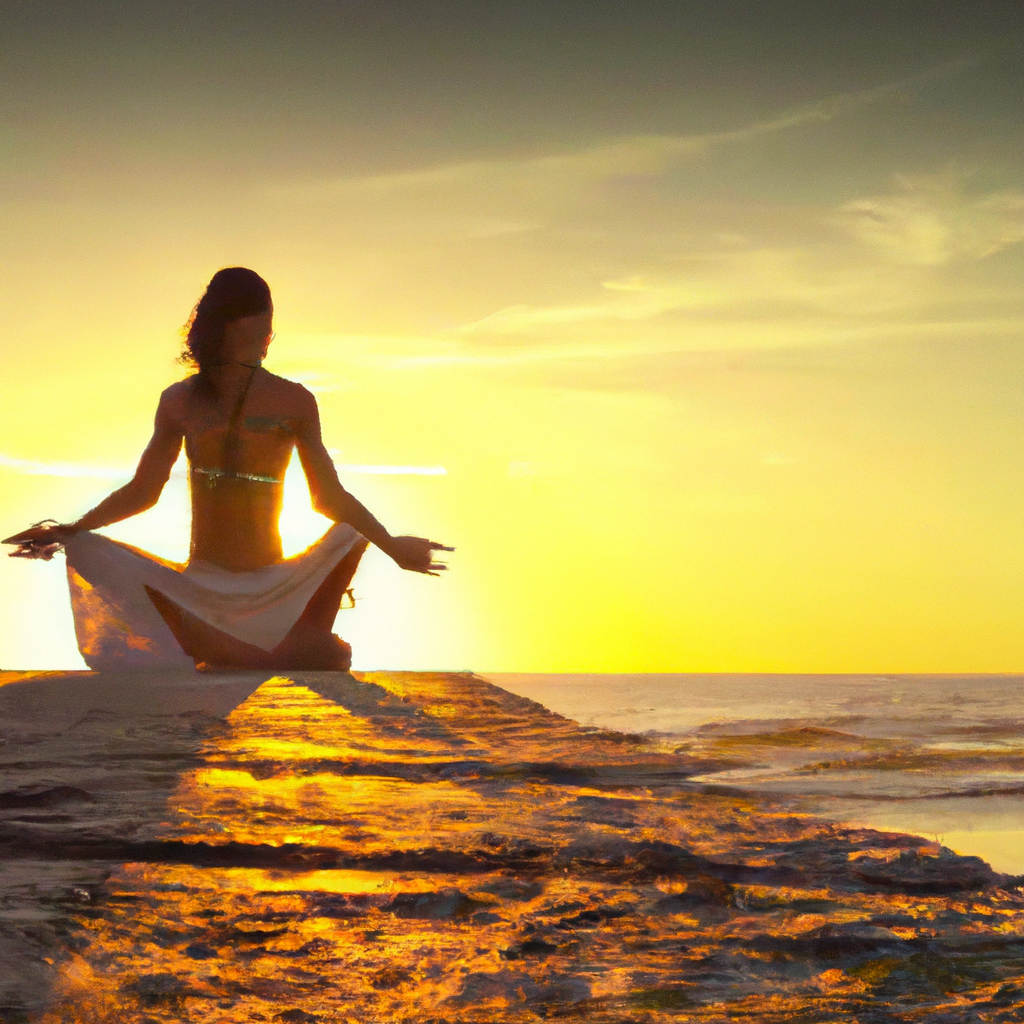Imagine the soft sand between your toes, the sound of gentle waves crashing, and the warm sun kissing your skin as you find your inner peace. The beach not only provides a stunning backdrop for relaxation, but it also offers the perfect opportunity to practice yoga or meditation. Whether you’re a seasoned yogi or a beginner looking to embrace mindfulness, the beach creates a tranquil environment that enhances your practice. So grab your mat or find a comfortable spot in the sand, and let the soothing nature of the beach guide you towards a blissful state of serenity.

Benefits of Practicing Yoga or Meditation on the Beach
Practicing yoga or meditation on the beach offers a wide range of benefits for both your physical and mental well-being. The combination of the tranquil environment and the soothing sound of waves can enhance your practice and deepen your connection with nature.
Physical Benefits
Engaging in yoga or meditation on the beach can provide numerous physical benefits. The sandy surface of the beach provides a natural cushion that is softer on your joints compared to hard surfaces like concrete or wood. This cushioning effect can help reduce the risk of injury and make your practice more comfortable. Additionally, practicing yoga or meditation on the beach requires engaging your core muscles more to maintain balance on an uneven surface, thus providing a more challenging and beneficial workout. The beach also offers an ideal setting for outdoor activities such as walking or swimming, allowing you to incorporate additional physical exercise into your routine.
Mental and Emotional Benefits
Practicing yoga or meditation on the beach can have a profound impact on your mental and emotional well-being. The soothing sounds of the ocean and the gentle sea breeze create a serene and calming atmosphere that helps to reduce stress and promote relaxation. The combination of fresh air, natural scenery, and the rhythmic sound of the waves can help to clear your mind, increase your focus, and induce a sense of peace and tranquility. Moreover, being in nature has been shown to boost mood, improve mental clarity, and provide a sense of mindfulness and grounding. This can greatly contribute to a more positive and balanced mindset.
Connection with Nature
One of the unique benefits of practicing yoga or meditation on the beach is the opportunity to connect with and immerse yourself in nature. The beach provides a natural and open space where you can feel the sand between your toes, observe the ebb and flow of the tides, and witness the beautiful colors of the sunrise or sunset. This connection with nature can elicit a sense of awe and wonder, helping you to feel more connected to the earth and the world around you. The beach offers a peaceful and harmonious setting that allows you to escape from the hustle and bustle of daily life and find solace in the beauty of nature.
Preparing for Your Beach Yoga or Meditation Session
Before heading to the beach for your yoga or meditation session, there are a few important factors to consider in order to ensure a safe and enjoyable experience.
Choosing the Right Location
When selecting a location for your beach yoga or meditation practice, it’s essential to choose a spot that is away from crowds and distractions. Look for a secluded area where you can find peace and solitude. Ideally, you should choose a spot that provides a decent amount of shade to protect yourself from the hot sun during peak hours. Additionally, consider the accessibility of the location and ensure that it is easily reachable and safe to access.
Checking the Weather
Before heading to the beach, be sure to check the weather forecast for the day. Avoid practicing in extreme weather conditions such as heavy rain, strong winds, or thunderstorms. The beach can be a serene and relaxing environment, but it can also present potential hazards if the weather turns unfavorable. Plan your session for a time when the weather is conducive to outdoor activities and be prepared to adjust your plans accordingly.
Practicing Sun Safety
Spending time in the sun can be invigorating, but it’s essential to take precautions to protect yourself from harmful UV rays. Apply sunscreen with a high SPF before heading to the beach and reapply it regularly, especially if you plan to practice during peak sun hours. Wearing a wide-brimmed hat and sunglasses can provide additional protection for your face and eyes. Consider wearing lightweight and breathable clothing that covers your skin to reduce the risk of sunburn. Remember to stay hydrated by drinking plenty of water throughout your session.
Carrying Essential Beach Gear
Before heading to the beach, prepare a bag with essential items to ensure a comfortable and enjoyable experience. Some items you may want to include are a large beach towel or yoga mat to provide a clean and comfortable surface for your practice, a water bottle to stay hydrated, a lightweight blanket for warmth or relaxation, and any props or accessories that enhance your yoga or meditation practice, such as blocks, straps, or cushions. Consider also bringing a portable speaker to play soothing music or guided meditation to enhance your experience.
Yoga Poses Suitable for the Beach
Certain yoga poses are particularly well-suited for practicing on the beach, taking advantage of the unique environment and enhancing your connection with nature. Here are a few poses you can incorporate into your beach yoga session:
Tadasana (Mountain Pose)
Stand tall with your feet parallel and hip-width apart. Press your feet firmly into the sand, grounding yourself and feeling the connection with the earth. Extend your arms by your sides, reaching towards the sky, and engage your core muscles. Close your eyes and focus on your breathing, feeling the gentle ocean breeze on your skin as you find your inner strength and stability.
Adho Mukha Svanasana (Downward-Facing Dog Pose)
Start in a tabletop position with your hands directly under your shoulders and your knees under your hips. Begin to lift your knees off the ground, straightening your legs and forming an inverted “V” shape with your body. Press your hands firmly into the sand, allowing your head and neck to relax between your arms. Feel the stretch in your hamstrings and the opening in your upper back as you surrender to the grounding energy of the beach.
Virabhadrasana II (Warrior II Pose)
From a standing position, step your feet wide apart, with your right foot facing forward and your left foot turned out to the side. Bend your right knee, ensuring it is directly above your ankle, and extend your arms out to the sides, parallel to the ground. Gaze over your right fingertips, taking in the vastness of the ocean and embodying the strength and determination of a warrior. Repeat on the other side.
Uttanasana (Standing Forward Bend Pose)
Stand with your feet hip-width apart and fold forward at your hips. Allow your upper body to dangle freely, relaxing your head and neck. Bend your knees slightly if needed to release any tension in your back. Feel the grounding sensation as your hands reach for the sand, and take a moment to surrender and let go of any stress or tension. Enjoy the calming sound of the waves as you find stillness in this pose.
Balasana (Child’s Pose)
Kneel on the sand with your toes touching and your knees wide apart. Sit back on your heels and fold forward, extending your arms out in front of you. Rest your forehead on the sand and surrender your body’s weight into the earth. Close your eyes and focus on your breath, allowing your body to relax and rejuvenate. Feel the gentle support of the sand beneath you, nurturing you as you find a sense of peace and surrender.
Meditation Techniques for the Beach
In addition to yoga, the beach provides an ideal setting for practicing meditation. Here are a few meditation techniques that you can incorporate into your beach meditation session:
Focused Attention Meditation
Choose a focal point, such as the horizon or a particular object on the beach, and concentrate your attention on it. Allow your mind to become fully absorbed in the present moment, observing any thoughts or distractions without judgment and gently returning your focus to your chosen point of concentration. This type of meditation can help sharpen your concentration and cultivate a sense of inner calm.
Breathing Meditation
Find a comfortable seated position, close your eyes, and bring your attention to your breath. Notice the sensation of the breath as it enters and leaves your body. Observe the natural rhythm of your breath without trying to control it. If your mind wanders, gently bring your focus back to your breath. This simple yet powerful meditation technique can help you cultivate mindfulness and deepen your connection to the present moment.
Loving-Kindness Meditation
Sit comfortably and bring to mind someone you love or care for deeply. Begin by silently offering them words of loving-kindness, such as “May you be happy, may you be healthy, may you live with ease.” As you continue to repeat these phrases, gradually expand your focus to include yourself, a neutral person, and even someone you may find challenging. This practice cultivates compassion, empathy, and a sense of interconnectedness.
Walking Meditation
Take off your shoes and feel the sensation of the sand beneath your feet. Slowly walk along the shore, paying attention to each step and the movement of your body. Notice the sensory experiences, such as the feeling of the sand, the sound of the waves, and the air on your skin. As you walk, allow your thoughts to come and go without holding onto them. Walking meditation combines physical movement with mindfulness, enabling you to fully immerse yourself in the present moment.

Tips for an Effective Beach Yoga Session
To make the most of your beach yoga session, here are some tips to help you optimize your practice:
Warm-up and Stretch Properly
Before diving into your yoga sequence, it’s important to warm up your body and prepare it for the movements to come. Spend a few minutes engaging in gentle stretching exercises, focusing on the areas that may feel tense or tight. This will help increase your flexibility and prevent injuries during your practice.
Use a Yoga Mat or Towel
While the natural surface of the beach can provide a cushioning effect, using a yoga mat or towel can help create a stable and clean space for your practice. A mat or towel offers more grip and can prevent your hands and feet from sinking into the sand, allowing you to maintain better balance and stability in your poses.
Adjust Poses for Balance and Stability
The sandy terrain of the beach can be slightly unstable, so it’s important to make adjustments to your poses to ensure balance and stability. Widen your stance in standing poses, engage your core muscles, and ground your feet firmly into the sand to maintain a steady foundation. Remember to listen to your body and make modifications as needed to ensure your safety and comfort.
Practice Mindful Breathing
Incorporating mindful breathing into your beach yoga session can deepen your practice and enhance your mind-body connection. Pay attention to your breath as you move through each pose, inhaling and exhaling slowly and deliberately. Feel the expansion and contraction of your lungs, and let each breath guide your movements, allowing you to flow with ease and grace.
Ensuring a Successful Beach Meditation Session
To have a successful beach meditation session, follow these tips to create an optimal environment for relaxation and mindfulness:
Find a Comfortable Seating Position
Choose a seating position that allows you to feel grounded and relaxed. You may choose to sit cross-legged directly on the sand or use a cushion or fold your towel to provide additional comfort and support. Experiment with different positions to find what works best for you and allows you to maintain an upright and relaxed posture.
Focus on Breath and Relaxation
As you settle into your meditation, redirect your attention to your breath. Allow your breath to guide your awareness and become fully present in the moment. As you breathe in the salty ocean air, notice the sensations in your body and the rhythm of your breath. Release any tension or worries with each exhale, allowing your body and mind to relax.
Embrace Sounds and Sensations
One of the unique aspects of practicing meditation on the beach is the abundance of natural sounds and sensations. Instead of being a distraction, embrace these external stimuli and use them as anchors for your meditation. Listen to the sound of the waves, the seagulls, or the soft rustling of leaves. Feel the warmth of the sun on your skin or the gentle caress of the breeze. Allow these sensory experiences to deepen your presence and connection with nature.
Release Expectations and Judgment
In meditation, it’s essential to let go of any expectations or judgments. Embrace each moment as it comes, without trying to force or control it. Recognize that thoughts and distractions will arise, but instead of attaching to them, simply observe them without judgment and gently bring your attention back to the present moment. Embrace the nature of impermanence, and allow yourself to be fully present in the ever-changing beauty of the beach.

Dealing with Common Challenges
Despite the many benefits, practicing yoga or meditation on the beach can present some challenges. Here’s how you can address them effectively:
Interruptions and Distractions
One of the challenges of practicing on the beach is the potential for interruptions and distractions. Beachgoers, noise, and other external factors can disrupt your focus. To minimize these interruptions, try to find a secluded spot away from crowds. Consider using noise-canceling headphones or playing soothing music to create a more peaceful atmosphere. Remind yourself that occasional distractions are a part of practicing in a public space and try to embrace them as opportunities for greater focus and resilience.
Sunburn and Overexposure to the Sun
Spending time in the sun can be enjoyable, but it’s important to protect yourself from overexposure and prevent sunburn. Apply sunscreen with a high SPF before your beach session, even on cloudy days. Reapply sunscreen regularly, especially if you’re sweating or spending an extended period under the sun. If possible, schedule your session during the cooler hours of the day, such as early morning or late afternoon, to reduce the risk of sunburn and ensure a more comfortable experience.
Unpredictable Weather
While the beach offers a scenic and peaceful environment, the weather can be unpredictable. Keep an eye on the weather forecast before venturing out and be prepared to adapt your plans if needed. If rain or thunderstorms are imminent, it’s best to reschedule your session for another time. Alternatively, you can bring a lightweight umbrella or seek shelter under a beach canopy to continue your practice in case of light rain or excessive heat.
Alternative Locations for Yoga or Meditation
If the beach is not accessible or doesn’t suit your preferences, there are other natural settings where you can practice yoga or meditation. Consider these alternative locations that offer their own unique benefits:
Lake or River Banks
Lakes or river banks can provide a tranquil and serene setting for your practice. The calm waters and the surrounding greenery create a soothing atmosphere that promotes relaxation and a deeper connection with nature. Look for a peaceful spot with a clear view of the water, and you can practice yoga or meditation while enjoying the serene surroundings.
Forest Clearings
Forests are known for their tranquility and natural beauty, making them an excellent choice for practicing yoga or meditation. Find a clearing with soft ground cover, such as grass or moss, where you can lay your mat or towel. Embrace the sounds of rustling leaves and birdsong as you connect with the peace and serenity of the forest.
Rooftop Gardens
Rooftop gardens provide a unique oasis in urban environments. These green spaces offer the opportunity to practice yoga or meditation surrounded by plants and flowers, away from the noise and distractions of the city. Look for rooftop gardens in hotels, apartments, or public buildings that allow access to the public or inquire about joining rooftop yoga or meditation classes in your area.

Joining Beach Yoga or Meditation Classes
If you prefer to practice in a group setting or would like to learn from experienced instructors, consider joining beach yoga or meditation classes. Here are some things to keep in mind:
Research Local Beach Yoga or Meditation Classes
Research online or inquire at local wellness centers or community centers to find beach yoga or meditation classes in your area. Read reviews and ratings to ensure the classes are led by qualified and experienced instructors. Reach out to class organizers or instructors to get more information about the sessions, schedules, and any specific requirements.
Benefits of Group Classes
Joining a group class allows you to practice yoga or meditation alongside like-minded individuals, creating a supportive and motivating environment. Practicing in a group can enhance your sense of community, provide opportunities for shared experiences, and deepen your understanding and connection to your practice. In addition, instructors can provide guidance, corrections, and modifications to ensure your safety and help you improve your technique.
Considerations for Beginners
If you’re new to yoga or meditation, attending a beginner-friendly class is highly recommended. Beginner classes typically focus on foundational poses and techniques, providing a solid introduction to the practice. Instructors will guide you through each step, helping you develop proper alignment, breath control, and mindfulness skills. Don’t be afraid to ask questions and seek guidance from your instructor to make the most out of your experience.
Joining Online Yoga or Meditation Sessions
If joining in-person classes is not feasible or convenient, you can also explore online yoga or meditation sessions. Many experienced instructors offer online classes that you can access from the comfort of your own home. These sessions often include pre-recorded videos or live stream classes, allowing you to practice at your own pace and within your own schedule. Seek out reputable online platforms or instructors who provide high-quality content and offer a range of classes suitable for various levels and interests.
Closing Thoughts
Practicing yoga or meditation on the beach can be a truly transformative and enriching experience. The combination of the physical exercise, mental stillness, and connection with nature creates a harmonious practice that nurtures both your body and mind. By embracing the benefits of practicing yoga and meditation outdoors, you can cultivate a deeper sense of well-being, balance, and mindfulness. So grab your mat or towel, find a peaceful spot on the beach, and embark on a journey of self-discovery, serenity, and inner growth. Remember to experiment with different locations and techniques to create a practice that resonates with your unique needs and preferences.


